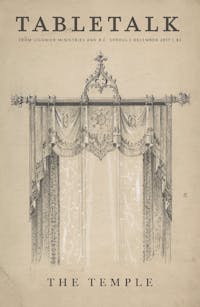
Request your free, three-month trial to Tabletalk magazine. You’ll receive the print issue monthly and gain immediate digital access to decades of archives. This trial is risk-free. No credit card required.
Try Tabletalk NowAlready receive Tabletalk magazine every month?
Verify your email address to gain unlimited access.
For many of us, the dining room table may be the most treasured place in our home. This is not simply because of the sustenance received there, but also because of the cherished interaction that takes place with family and friends over a shared meal.
Our own experience of mealtime enables us to better appreciate the symbolism of the table of bread in the tabernacle. Located on the right (north) side of the Holy Place, the table was made of acacia wood and overlaid with pure gold (Ex. 25:23–30; 37:10–16). It measured about three feet long, one and a half feet wide, and two feet three inches tall. A rim encompassed the outside of the tabletop, and four legs with four attached gold rings supported it. When it was time to move the table, poles would be slipped through the four rings to carry it. Also, plates, dishes, jars, and bowls were made of pure gold and placed upon it. The plates and dishes likely held the frankincense, and the jars and bowls were apparently used for libations (drink offerings).
The primary purpose of the table was to hold “the bread of the presence” (literally, “the bread of the face”), which was set before the presence/face of Yahweh (Ex. 25:30). Each Sabbath, the priests would replace the loaves from the previous week with a fresh batch of bread (Lev. 24:5–9). Exactly twelve loaves were arranged into two rows of six, and these loaves represented the twelve tribes of Israel. These loaves were a food offering to God that was to be perpetually carried out as “a covenant forever” (Lev. 24:8).
Along with the other elements of the tabernacle, the table highlights the covenantal relationship between God and His people as Yahweh dwells with Israel in a special manner. While much could be said about this table, there are two main things to note.
First, the table of bread emphasizes God’s provision for Israel. God is the Creator and covenant Lord who has promised to redeem and care for them. As the source of their life, He gives them their daily bread (like the “manna” in the wilderness; Ex. 16:1–36). But even more so, He is the source of their eternal life. And the people acknowledge these things by participating in the food offering ritual of the table. They provide a portion for the table out of the abundance of what God has given them. In this way, the people show their gratitude and worship the covenant Lord.
Second, the table highlights the intimate fellowship that exists between God and His people. In the Bible, a shared meal was a time of close fellowship between people, especially in the context of a covenant (for example, Abraham’s meal with God in Gen. 18:1–9). Significantly, the previous chapter in Exodus furnishes a wonderful example of this. In Exodus 24:9–11, after God gave His law to Israel, Moses and the elders went up the mountain to eat a meal with the Lord, and the text wondrously tells us that at that time they saw God (vv. 10–11). This was the covenant meal that commemorated the relationship between Yahweh and Israel. Eating in the presence of God revealed that Israel was intimately known and loved by Him. So as the twelve loaves were a food offering to Yahweh and were later eaten by the priestly representatives of the people, the table became a perpetual reminder of the intimate fellowship that God shared with His people.

These Old Testament elements are shadows of better realities that have come to the church in Jesus Christ (Heb. 10:1). He is the fullest expression of the tabernacle/temple as the presence of God among His people (Matt. 1:23; John 1:14; 2:19–21). Through Him, God provides life to the church both now (Matt. 6:11; Phil. 4:19) and eternally (John 3:16; Acts 4:12). The bread of the presence ultimately pointed to Jesus as the bread of heaven (John 6:22–65). He is the bread of life (vv. 35, 48), the true heavenly manna (vv. 30–33), and everyone who eats His flesh and drinks His blood (i.e., believes in Him) has eternal life (vv. 51–58).
This act of feeding upon Christ by faith is symbolized in the Lord’s Supper (1 Cor. 11:23–26), which is not restricted to priests as the old covenant bread of the presence was. At the new covenant meal, all believers now engage in intimate fellowship with the triune God, and together, the church sees that they are known and loved by Him. The Lord’s Table also points forward to the glorious marriage supper of the Lamb, where Christ and His church will fellowship forever (Rev. 19:6–9). This is the table that God is preparing for those who love Him—rather, who are loved by Him.
